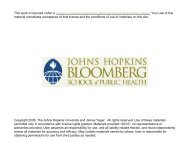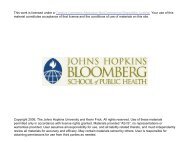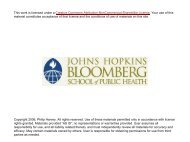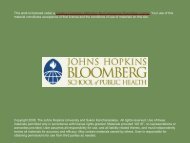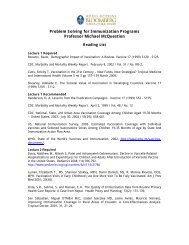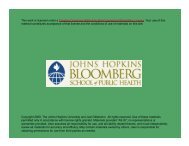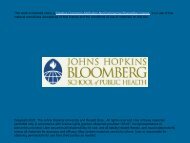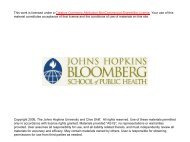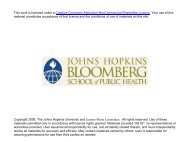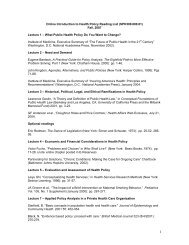Assignment #2 - jhsph ocw - Johns Hopkins Bloomberg School of ...
Assignment #2 - jhsph ocw - Johns Hopkins Bloomberg School of ...
Assignment #2 - jhsph ocw - Johns Hopkins Bloomberg School of ...
Create successful ePaper yourself
Turn your PDF publications into a flip-book with our unique Google optimized e-Paper software.
V. Instructions / Logistics<br />
1) This paper should be about ten pages in length (double spaced, 12 point font). The intent <strong>of</strong><br />
this assignment is to provide an avenue for you to explore new areas, but within the<br />
framework <strong>of</strong> the assignment.<br />
2) You may make any reasonable assumptions you wish in writing this memo/research plan and<br />
may “bend” (though not “break”) reality to set up a specific context/scenario that interests you.<br />
Feel free to expand on the information given in the case study to flesh out the situation.<br />
Creativity and innovation are always encouraged, but do remain concrete and focused (as the<br />
three formats require).<br />
3) Even if you choose one <strong>of</strong> the case studies provided above, you are encouraged to develop a<br />
special “spin/focus” within these boundaries if that would make your assignment more<br />
relevant. Make sure your special emphasis is clearly delineated in your paper’s introduction.<br />
4) Again, please remember that you are doing this paper for a course on Managed Care/ health<br />
insurance. The majority <strong>of</strong> your paper (though not the entire paper) should focus on issues<br />
that are clearly within the domain <strong>of</strong> Managed Care. The integration and synthesis <strong>of</strong> course<br />
material is a major grading criterion.<br />
5) For all paper options, special emphasis should be placed on exploring the literature. If<br />
appropriate (which in most cases it will be) at least 10-15 articles should be cited. No more<br />
than half <strong>of</strong> the references should come from your “required” reading list. You are encouraged<br />
to use articles from the course’s extensive “additional” reading list and web links.<br />
6) As noted in the format section, while decision memos and business plans do not normally<br />
include references, citations are expected for this assignment. Be mindful to cite from the<br />
literature for all claims you make in your paper.<br />
We hope you find this to be a useful exercise that augments your career preparation in a manner<br />
relevant to you. If you have suggestions for how this exercise can be improved, such feedback is<br />
appreciated.<br />
VI. Some Suggestions for Writing a “Decision Memorandum”<br />
A decision memorandum is used by policy analysts to synthesize information regarding a problem and<br />
to succinctly communicate this information to policy makers. A decision memo should outline the<br />
magnitude <strong>of</strong> the problem, provide background for current policies, describe and critique two or more<br />
policy options, and suggest a final course <strong>of</strong> action and the rationale for choosing it.<br />
There are a few key points to writing an effective decision memo. First, writing should be<br />
straightforward and concise. Second, the memo should be well organized and clearly presented. The<br />
use <strong>of</strong> headings, bullets, etc. can assist the reader in identifying the most important points. Third, the<br />
memo should reflect the points, issues, etc. that are most relevant to the recipient. Concerns <strong>of</strong> a<br />
hospital administrator, for example, may be very different from the Administrator <strong>of</strong> CMS (formerly<br />
HCFA), even when confronted with similar problems.<br />
Whether it’s part <strong>of</strong> the memo itself or in a brief preface for this exercise, make sure the reader<br />
(grader) is clear what the context <strong>of</strong> this memo is and the “role” you are playing in terms <strong>of</strong> who you<br />
are writing this for, who the writer is and the appropriate context. As noted in the assignment you may<br />
make any “reasonable” assumption about the context you wish, but make sure these assumptions are<br />
clear to the reader.<br />
3



